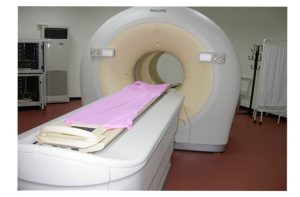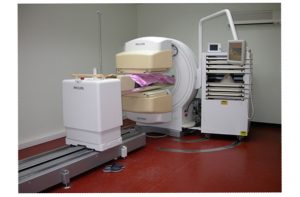NUCLEAR MEDICINE
Nuclear Medicine is a branch of medicine that provides diagnosis by counting the rays emitted by radioactive substances given to living things with special methods or transforming them into images with devices. Dokuz Eylul University Department of Nuclear Medicine has been serving since 1991.
There are 3 Gamma Cameras, 1 SPECT/BT device, 1 PET/BT, 1 gamma probe in our department. There are also uptake device, gamma counter, dose calibrator, area measuring devices and laminar air flow.
Our department has a wide range of examinations in the field of imaging.
SINTIGRAPHIES IN THE DEPARTMENT
Tc-99m thyroid scintigraphy
I-131 thyroid scintigraphy
I-131 thyroid uptake
I-131 whole body scan
Parathyroid scintigraphy
DTPA kidney scintigraphy
DMSA kidney scintigraphy
MAG3 kidney scintigraphy
Radionuclide cystoureterogram
Testicular scintigraphy
Bone scintigraphy
Bone marrow scintigraphy
Three-Phase Bone Scintigraphy
Myocardial perfusion scintigraphy
I-123 MIBG sympathetic innervation scintigraphy
Shunt analysis
Lymphoscintigraphy
Brain perfusion scintigraphy
Tc-99m HMPAO brain SPECT
Cisternography
CSF leak detection
CSF shunt evaluation
GI bleeding detection
Esophageal transit time and motility study
Gastric emptying time calculation
Gastroesophageal reflux scintigraphy
Meckel scintigraphy
Liver-Spleen scintigraphy
Lung perfusion scintigraphy
Lung ventilation scintigraphy
Tumor imaging with Octreotide
MIBG scintigraphy
I-131 MIBG therapy
I-131 treatment
Salivary gland scintigraphy
Dacryoscintigraphy
VUR Scintigraphy
Brain perfusion scintigraphy with Tc-99m DTPA
Scintimammography
Mass localization with gamma probe
PET/CT IMAGINGS IN THE DEPARTMENT
Tumor imaging with PET (with FDG)
Prostate cancer imaging with PET (Ga-68 PSMA)
Neuroendocrine tumor imaging with PET (Ga-68 DOTATATE)
Myocardial imaging with PET (with FDG)
Brain imaging with PET (with FDG)
Bone imaging with PET (with NaF)
RADYONUCLIDE TREATMENTS IN THE DEPARTMENT
Radioactive Iodine Therapy (I-131)
Neuroendocrine tumor therapy (Lu-177 DOTATATE)
Prostate cancer metastasis treatment (Lu-177 PSMA)
Intra-arterial microsphere therapy (Y-90 SIRT)
MIBG Treatment (I-131 MIBG)
Intra-Joint Treatment (Y-90)
Pain Palliation Therapy (Sm-153)
PET/CT
PET/CT device has the latest technological equipment. With this device, functional and anatomical imaging information is obtained simultaneously. PET/CT imaging is vital in the diagnosis and staging of oncological diseases, evaluation of response to treatment, prognosis, and detection of recurrent disease. It is also used in the evaluation of heart muscle viability and brain metabolism. The follow-up and guidance of the patients in the imaging and preparation phases is done with closed circuit camera-announcement systems.

GAMMA CAMERAS
There are 3 gamma cameras in our department. Dynamic, static and SPECT images can be made with each gamma camera, and the images are stored in the PACS system. There is a television and DVD player for our pediatric patients to watch cartoons during imaging.

TREATMENT CENTER
Radionuclide therapy is the treatment of diseases with substances that emit radiation or with the help of chemical molecules (radiopharmaceuticals) labeled with these substances. The main areas of use of radionuclide therapy are the treatment of hyperthyroidism and thyroid cancers, prostate carcinoma, neuroendocrine tumors, liver cancer, liver metastases, painful joints (radionuclide synovectomy), some types of lymphoma, and the elimination of pain in bone metastases. Our center, which has been serving at a near full capacity since it was put into service, is a center where patient safety is tried to be realized at the highest rate by providing 24-hour uninterrupted health service with the on-call system as well as patient comfort and convenience.
There are four patient rooms in our radionuclide treatment center, which we started to accept patients in July 2007. One of these rooms is arranged as a patient accompanist room. This room has been planned to allow patient accompanists to stay with children or elderly patients. The most important feature of the rooms is that their walls are “lead lined”. In addition, patient wastes such as urine and faeces are delivered to holding tanks through leaded discharge pipes. Patient wastes are kept in holding tanks until the amount of radiation is reduced that can be given to the city sewer. Since our patients have to stay in their rooms during their treatment, there are devices such as television, DivX player, refrigerator, tea and coffee maker in the patient rooms. Internet connection is available for computer use in each room.
Radionuclide Therapy:
Radioactive Iodine Therapy (I-131)
MIBG Treatment (I-131 MIBG)
Radioimmunotherapy
Intra-articular Treatment
Pain Palliation Therapy
Somatostatin Receptor Therapy

